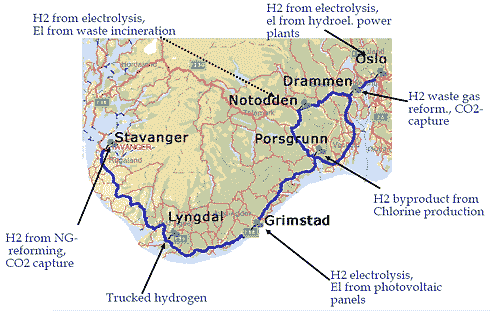Norway HyNor Project
Imagine a working hydrogen test facility that spans a large portion of a nation. Imagine setting the standard for the world to follow. Imagine a “Hydrogen Highway” in the heart of Norway. Imagine no longer since this is becoming a reality very soon.
 Norway HyNor Corridor |
The Norway HyNor Project is developing rapidly between the cities of Oslo and Stavanger. This project will provide a sensible means of providing hydrogen transportation along a test strip some 350 miles in length from the years 2005 to 2008. The project will also be quite challenging because of wide variations in climate and topology including very cold seasonal temperatures, not conducive to many fuel cell vehicles.
As part of the signed Kyoto Treaty, Norway realized cutting emissions from power production was not a viable option, but perhaps they could take a bold step forward in implementing the infrastructure needed for a common and accessible means of hydrogen refueling. This alternative made sense because the emissions from hydrogen vehicles is zero compared to fossil fuel based vehicles which chug 1.5 billion tons of gas emissions into the environment.
The Norway HyNor Project is working with both governmental agencies as well as the private sector to produce this hydrogen corridor. The plans include the commercial feasibility of large-scale hydrogen fuel based vehicles such as cars, taxis, trucks and buses. Private vehicles will also be used in this globally anticipated study and fueling stations are slated to be completed so that a real-world test case can provide the evidence needed for a shift in the world’s fuel dependence.
As one might image, the Norway HyNor Project has gained substantial support from global environmental groups. The main support, however for this hydrogen highway system has come from energy and transportation companies along with public authorities and research and development institutions.
Currently, Norway generates much of their energy for homes and businesses through hydro-power and biomass. In fact, Norway has a long history of hydrogen generation by electrolysis through the use of hydro-power. The use of renewable energy resources for creating hydrogen are expected to serve as a model for other nations contemplating the move to a hydrogen-based economy.
The Norwegian government has also made the unprescendented move of offering tax incentives for hydrogen cars and vehicles. Registration fees and annual vehicle taxes will be removed starting January 1, 2007, lifting some of the barriers of the commercialization for hydrogen vehicles.
On May 9, 2006, Quantum Fuel Systems announced that they have received an order from the Norway HyNor project for 15 Toyota Prius Hybrids to be converted to run on hydrogen gas. The vehicles will be put into service later in 2006 and in 2007 as part of the project.
The ultimate achievement would be for the world to recognize that a model for hydrogen transportation is feasible, practical and happening right now. If the Norway HyNor Project is successful, a national infrastructure will be achieved in a few short years with the well noted environmental benefits of hydrogen fuel firmly in place. In that moment, the world may begin to see a rapid readjustment to an entirely new fuel supply.
Most current car manufacturers have concept vehicles that are fueled by hydrogen and have had very positive test results from these vehicles. As more and more hydrogen refueling stations become available, the switch to hydrogen fuel based vehicles will move the world from imagination to a common sense reality. In order to see what is happening in the U. S., check out the information on the California Hydrogen Highway corridor.
More Info From Our Blog